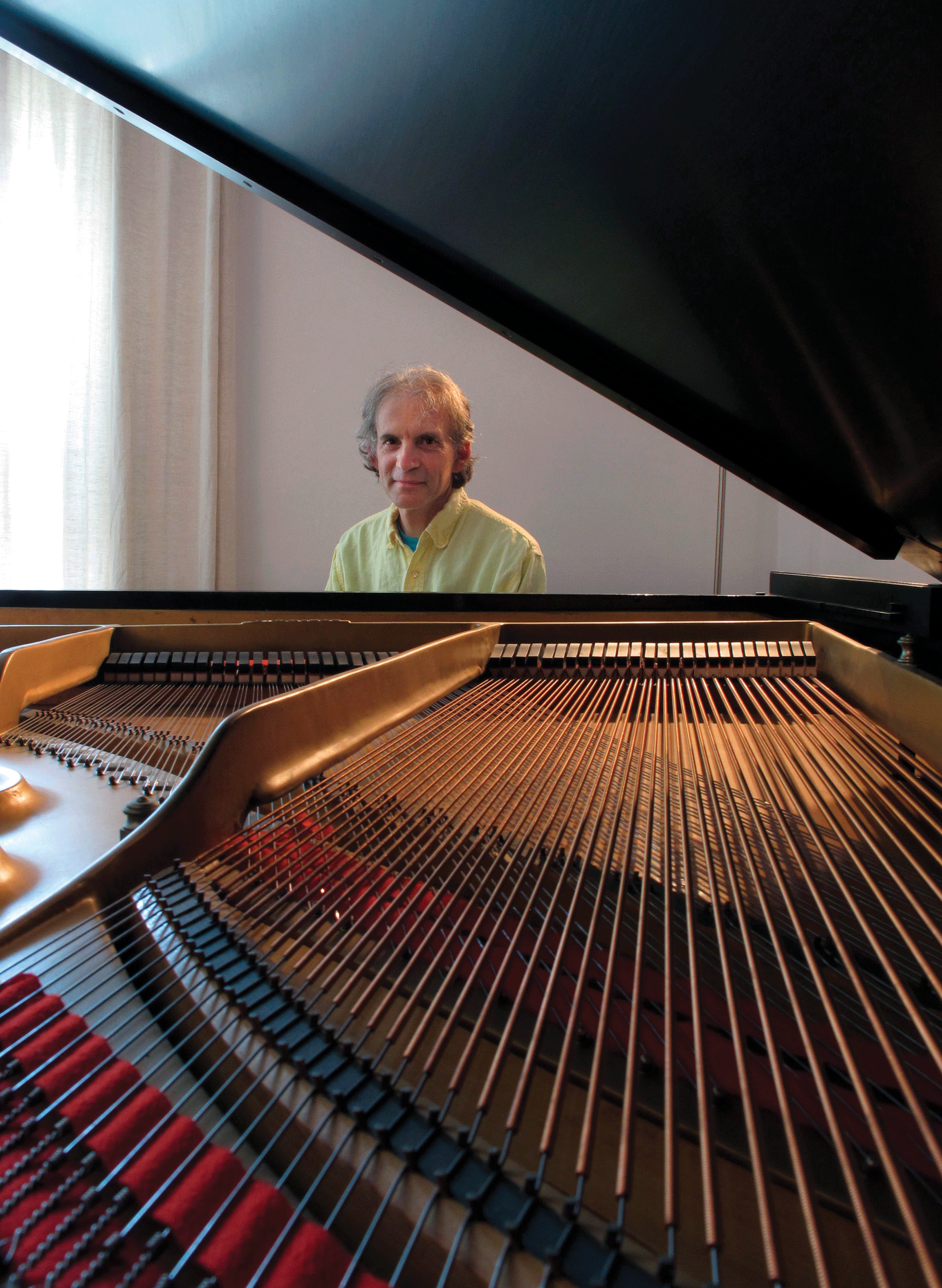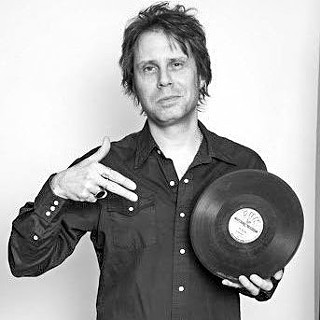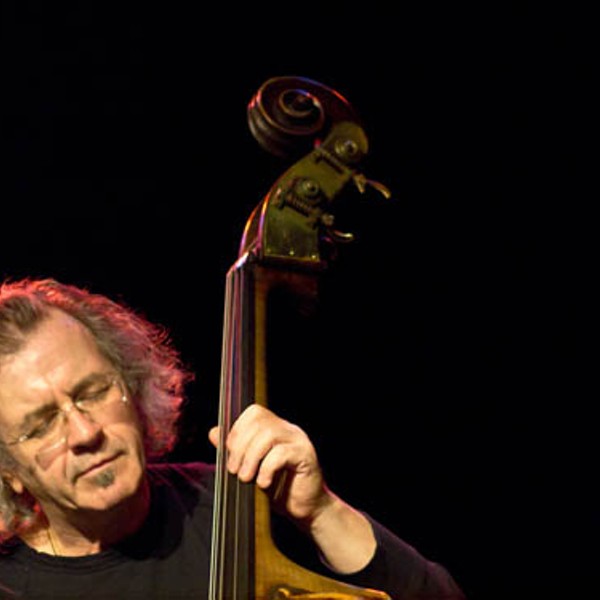David Arner
Stars Aligned
[]
Not five minutes from the campus of Bard College is Barrytown, a shady hamlet of Red Hook tucked along the edge the Hudson. Sitting there like a tiny toy is the area’s former post office and general store, a one-room 18th-century shoebox reopened this year as the Barrytown Archive arts space. Inside, David Arner, on keyboard and balafon, and George Quasha, on Roland Octapad and snare drum, are playing before a packed house. Their unspoken conversation is animated. The squiggling blips and squeaks and the sampled organ and vibes emanating from Arner’s device comingle with Quasha’s frenzied tapping, which sounds at times like hard rain on a corrugated roof.
Between pieces, Arner looks over at his accompanist and calls out a number. “32,” he says. Quasha nods dryly, and plays. The piece ends. “43.” The next piece begins and ends. “35.” And so on. What is this, a secret language? Some arsenal of obscure aphorisms à la Brian Eno’s mysterious “Oblique Strategies” cards?
Arner laughs when the questions are put to him in his Kingston home the following day. “No, no,” he explains. “Those numbers were just the presets for George’s electronic drums, some sounds that we’ve found and liked as we’ve jammed over the years. What George does with those sounds, and what I do around them, aren’t planned at all. That music’s totally improvised, with no predetermined ideas.” With a pianist whose innovations have lately astonished the jazz world, one might be forgiven for assuming the shop talk was yet more evidence of his deep creativity.
Locally for several years, however, it was perhaps more as a curator of creativity that Arner was known. From 2003 to 2007 he ran the New Vanguard Series in Kingston, a vital weekly event that presented performances by the free jazz/improvised scene’s top players. Yet while he did play occasionally inside and outside of the series, Arner, 60, had largely put his own music aside. And since moving on from his self-sacrificing role he’s been knocking out acclaimed recordings and snagging high-profile gigs at music meccas like New York’s the Stone and elsewhere. It’s vindicating to see the pianist, whose startling style blends the bristly dissonance of Cecil Taylor with the fragile lyricism of Keith Jarrett, enjoying the renaissance that has him at last getting the attention he deserves.
Born and raised in Bayside, Queens, Arner was an explorer from a young age. “I loved riding my bicycle through the side streets, taking the bus and the train into Manhattan and going to museums and performances,” says the composer-musician, who counts among his formative experiences Leonard Bernstein conducting Beethoven's ninth symphony at one of the conductor's celebrated Young People’s Concerts; a 1964 Living Theatre staging of “The Brig”; a radio broadcast of Vladimir Horowitz’s 1965 Carnegie Hall return concert; a 1967 Joseph Papp production of “Hamlet” starring Martin Sheen; and a 1968 performance of “Astarte” by the Joffrey Ballet. The diversity of such a list would come to the fore in his work, which besides a wide range of musicians, includes collaborations with artists in dance, literature, and visual art. But it was music that grabbed him first, and his home was filled with it. “There was always classical music in the house,” he remembers. “My parents didn’t play, but my uncle and aunt were serious classical musicians. My grandfather died before I was born but I do know he played piano for silent films, which is ironic because that’s something I go into doing.” Arner began piano lessons at age nine and went on to study under the renowned Edna Golandsky. “We had a baby grand in the house, but it wasn’t very good,” he says. “In high school I got an inheritance and my parents took me to the Steinway showroom to pick out a grand, which I still have.”
It was while majoring in music, philosophy, and religion at Oberlin College that he connected with jazz. “This kid I made friends with played me three or so records from start to finish,” the pianist recalls. “Then he said, ‘Okay, now you’re ready” and put on a Coltrane album—My Favorite Things, I think. That just opened me up.” For his junior year Arner apprenticed with influential sound artist and composer Charlie Morrow, and a campus visit from the Merce Cunningham Dance Company, which then included John Cage and David Tudor, was also revelatory. Although he did play a 1973 one-off gig, on flute and percussion, in a box car in Grand Central Station with poet Jackson Mac Low for the 10th Annual Avant-Garde Festival, Arner remained “afraid to commit myself” to playing music. Upon graduation he instead worked as a roadie for rock bands, mixing monitors for The Band, the Grateful Dead, the Bee Gees, Labelle, the Jackson Five, Little Richard, Aretha Franklin, and other acts. He also began his ongoing association with the medium of dance, though as not as the simpatico accompanist he’s frequently worked as. “I went to see Meredith Monk to ask if she needed a sound engineer,” he says. “She looked at me and said, ‘No, you’re going to dance.’ I didn’t really dance, but I said yes anyway.” Arner appeared in Monk’s operas “Vessel” (1971) and “Education of the Girlchild” (1973) and lived in a Soho loft for a year with dancers from choreographer Yvonne Rainer’s troupe and Coltrane bassist Jimmy Garrison’s family.
He moved upstate in 1975 and finally and completely turned himself over to music, beginning a two-year regimen of practicing 10 hours daily and performing in collective improv unit Dream Time and various cover and wedding bands. In 1981 he became the music advisor of Bard College’s dance department, a position he would hold until 2009, and began to take flight as a creator of music for dance performances, serving as music director in Poughkeepsie for Jacques d’Amboise’s National Dance Institute and seeing his compositions for choreographers Aileen Passloff, Albert Reid, and Jeanette Leentvaar presented in Venezuela and France and at New York’s Merce Cunningham Studio. Arner served as a Bard composer-in-residence in 1998 and continues to teach at Bard as well as at Troy’s Rensselaer Polytechnic Institute.
In was also the ’80s Arner that began scoring and performing music for silent film. “I was hanging out with Steve Lieber from Upstate Films in Rhinebeck and he was talking about showing some silent movies,” the musician says. “And we both thought, ‘Why don’t we do live music?’” The keyboardist’s first foray as a film accompanist was at Upstate in 1986 for the Buster Keaton comedy The General (1926), and he’s since played for genre classics like F. W. Murnau’s The Last Laugh, J. M. Barrie’s Peter Pan (both 1924), and Victor Sjöström’s The Wind (1928); a 2009 retrospective of films by French pioneer Alice Guy Blaché at the Whitney Museum of American Art; and events at the American Museum of the Moving Image and the National Gallery of Art.
Along with dance and film, a fascination with mythology has informed much of Arner’s work. This includes two long-form opuses with the poet Charles Stein, 1992’s “Prometheus Project,” which was performed at the Knitting Factory and “explored collective composition though spontaneous consensus and was primarily focused on Greek mythology but covered a wide variety of related interests, including sound poetry, philosophy and tarot,” and “An Invocation of Hermes Twice Revealed,” a nine-part, semi-improvisational suite for piano, harpsichord, and spoken word based on the ancient Homeric Hymn to Hermes, which is part of Arner's "Planetary Invocations" series and was presented at EMPAC in Troy this past May.
The pianist’s first releases, the overtly named Solo Piano and the in-concert Live from the Center (2002 and 2005, respectively, Dogstar Records), led to his being cited by jazz bible Cadence as “an intense, introspective pianist who methodically constructs sound portraits of shattering dimensions...a discerning musician who retreats inwardly to project his obsessions externally.” For most of the last decade, though, he was devoted to overseeing the New Vanguard Series, which across 216 shows presented over 150 musicians from around the world. “[Cottekill saxophonist] Joe Giardullo had started the series under a different name but stopped doing it, so I stepped in,” explains Arner. “At first I called it New Directions in Jazz, and it was at the [now defunct] Uptown Cafe in the Stockade area. When the Uptown closed, it moved to the old Deep Listening Space in the Rondout and when that place closed we moved back to the Stockade, to Alternative Books.” For lovers of out jazz the New Vanguard was a godsend, hosting performances by saxophonists Joseph Jarman and Joe McPhee, trombonist Julian Priester, pianists Burton Greene and Dave Burrell (a former teacher of Arner’s), and bassist Dominic Duval, among other icons. But after four glorious years its booker was spent. “I needed a break,” he says. “It was great to do but very time consuming, particularly as volunteer work.” (Downloads of the series’ mind-expanding sets are now available through Deeplistening.org.)
From the New Vanguard’s ashes, however, emerged the David Arner Trio. The unit, which includes series veterans bassist Michael Bisio and drummer Jay Rosen, debuted in tandem in 2009 with Out/In the Open, on Polish label Not Two Records, and Porgy/Bess Act 1, the first of two volumes of inspired impressions of music from George Gershwin’s “Porgy and Bess” on the crucial CIMP imprint. “What really strikes me about David is how he brings his hard-core classical background to the music,” says Bisio, a sometime Troy resident who also performs with pianist Matthew Shipp. “He’s very gracious as a player and just allows [collaborators] to be who they are. Also, David’s an expert on birdsong and astrology. He’s a mystical cat.”
In addition to his performing at Manhattan’s renowned Vision Festival in 2010 with saxophonist Lorenzo Sanguedolce, Arner’s resume has expanded to include work with creative paragons like cellist Tomas Ulrich, guitarist Dom Minasi, and drummer Susie Ibarra. Another association, with pianist Connie Crothers, has proven incredibly fruitful. In May 2009 the pair recorded nearly four hours of music at Bard’s Fisher Center, which is newly out on French label RogueArt as the four-CD box set Spontaneous Suites for Two Pianos. As one might expect, it’s a lot to take in. A pristinely captured epic—or Homeric, perhaps, given Arner’s mythological interests—experience, the album boasts 11 extended, completely improvised pieces, most of which have been titled for their distinct segments (“Suite II: The Metropolis,” for example, comprises the bustling “City Rhapsody,” the tranquil “Night Through Dawn,” and the rising “In the Midst”). A document of two artists who share an uncanny telepathy, Spontaneous Suites is a modern landmark, the sound of two amazing-unto-themselves universes existing as their glittering constellations overlap.
More heavenly sounds are in store as Arner readies the celestially themed work “Planetary Invocations” and learns to use the Expanded Instrument System (EIS), an electronic signal processing system developed by Pauline Oliveros. The recipient of a Jazz Fellowship award from the National Endowment for the Arts and several Meet the Composer grants, the pianist says that at this point he’s “looking to get beyond the keyboard.” Considering the transcendent nature of his music, one might say he’s already there.
Spontaneous Suites for Two Pianos is out now on RogueArt Records.














